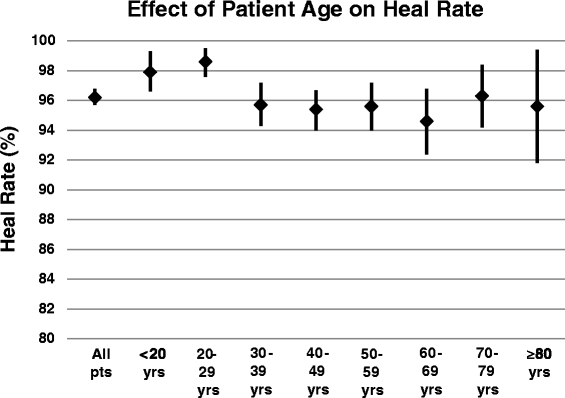A cohort study of 4,190 patients treated with low-intensity pulsed ultrasound (LIPUS): findings in the elderly versus all patients
- PMID: 25886761
- PMCID: PMC4357153
- DOI: 10.1186/s12891-015-0498-1
A cohort study of 4,190 patients treated with low-intensity pulsed ultrasound (LIPUS): findings in the elderly versus all patients
Abstract
Background: Patient age is one of many potential risk factors for fracture nonunion. Our hypothesis is that older patients (≥ 60) with fracture risk factors treated with low-intensity pulsed ultrasound (LIPUS) have similar heal rate (HR) to the population as a whole. We evaluate the impact of age in conjunction with other risk factors on HR in LIPUS-treated patients with fresh fracture (≤ 90 days old).
Methods: The Exogen Bone Healing System is a LIPUS device approved in 1994 to accelerate healing of fresh fracture. After approval, the FDA required a Post-Market Registry to assess performance. Patient data collected from October 1994 until October 1998 were individually reviewed and validated by a registered nurse. Four distinct data elements were required to report a patient: date fracture occurred; date treatment began; date treatment ended; and a dichotomous outcome of healed v. failed, by clinical and radiological criteria. Data were used to calculate two derived variables; days to treatment (DTT) and days on treatment (DOT). Every validated fresh fracture patient with DTT, DOT, and outcome is reported.
Results: The validated registry had 5,765 patients with fresh fracture; 73% (N = 4,190) are reported, while 13% of patients were lost to follow-up, 11% withdrew or were non-compliant, and 3% died or are missing outcome. Among treatment-compliant patients, HR was 96.2%. Logistic estimates of the odds ratio for healing are equivalent for patients age 30 to 79 years and all age cohorts had a HR > 94%. Open fracture, current smoking, diabetes, vascular insufficiency, osteoporosis, cancer, rheumatoid arthritis, and prescription NSAIDs all reduced HR, but older patients (≥ 60) had similar HRs to the population as a whole. DTT was significantly shorter for patients who healed (p < 0.0001).
Conclusions: Comorbid conditions in conjunction with aging can reduce fracture HR. Patients with fracture who used LIPUS had a 96% HR, whereas the expected HR averages 93%. Time to treatment was significantly shorter among patients who healed (p < 0.0001), suggesting that it is beneficial to begin LIPUS treatment early. Older patients (≥ 60) with fracture risk factors treated with LIPUS exhibit similar heal rates to the population as a whole.
Figures


References
Publication types
MeSH terms
LinkOut - more resources
Full Text Sources
Other Literature Sources
Medical

